
- Subject:
- Sociology
- Material Type:
- Unit of Study
- Provider:
- Rice University
- Provider Set:
- OpenStax College


Define technology and describe its evolution
Understand technological inequality and issues related to unequal access to technology
Describe the role of planned obsolescence in technological development
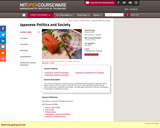
" This course is designed for students seeking a fundamental understanding of Japanese history, politics, culture, and the economy. "Raw Fish 101" (as it is often labeled) combines lectures, seminar discussion, small-team case studies, and Web page construction exercises, all designed to shed light on contemporary Japan."
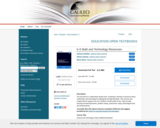
This document is a collaborative student work, comprising a directory of resources about mathematics and technology for kindergarten through fifth grade. This resource was created with the support of an ALG Textbook Transformation Grant. Topics include teaching and learning theories, problem solving, assessment, equity, technological tools, and measurements.
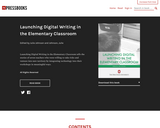
Launching Digital Writing in the Elementary Classroom tells the stories of seven teachers who were willing to take risks and venture into new territory by integrating technology into their workshops in meaningful ways.
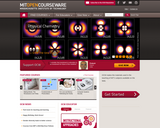
The Massachusetts Institute of Technology (MIT) OpenCourseWare (OCW) is a free and open educational resource for faculty, students, and self-learners around the world. OCW is a publication of MIT course materials both from the undergraduate and graduate levels. It does not require any registration, is not a degree-granting or certificate-granting activity, and does not provide access to MIT faculty. The course sites often contain lecture notes, problem sets, readings, assignments, exams, study materials, and other resources. Open courseware is available on a variety of subjects, including Earth, atmospheric, and planetary sciences, and can be used for self-study or curriculum development.
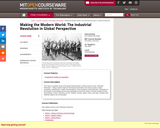
This class is a global survey of the great transformation in history known as the "Industrial Revolution." Topics include origins of mechanized production, the factory system, steam propulsion, electrification, mass communications, mass production and automation. Emphasis on the transfer of technology and its many adaptations around the world. Countries treated include Great Britain, France, Germany, the US, Sweden, Russia, Japan, China, and India. Includes brief reflection papers and a final paper.
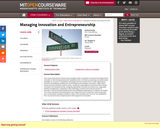
This course discusses the basics every manager needs to organize successful technology-driven innovation in both entrepreneurial and established firms. We start by examining innovation-based strategies as a source of competitive advantage and then examine how to build organizations that excel at identifying, building and commercializing technological innovations. Major topics include how the innovation process works; creating an organizational environment that rewards innovation and entrepreneurship; designing appropriate innovation processes (e.g. stage-gate, portfolio management); organizing to take advantage of internal and external sources of innovation; and structuring entrepreneurial and established organizations for effective innovation. The course examines how entrepreneurs can shape their firms so that they continuously build and commercialize valuable innovations. Many of the examples also focus on how established firms can become more entrepreneurial in their approach to innovation.
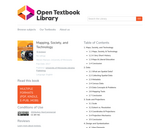
This book is about how to read, use, and create maps. Our exploration of maps will be informed by a contextual understanding of how maps reflect the relationship between society and technology, and how mapping is an essential form of scientific and artistic inquiry. We will also explore how mapping is used to address a variety of societal issues, such as land use planning and political gerrymandering. You will gain insight into the technical underpinnings of mapping as a science approach, complement on-going interest and activities, or provide an applied focus for research or policy.
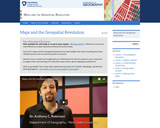
The past decade has seen an explosion of new mechanisms for understanding and using location information in widely-accessible technologies. This Geospatial Revolution has resulted in the development of consumer GPS tools, interactive web maps, and location-aware mobile devices. This course brings together core concepts in cartography, geographic information systems, and spatial thinking with real-world examples to provide the fundamentals necessary to engage with Geographic Information Science. We explore what makes spatial information special, how spatial data is created, how spatial analysis is conducted, and how to design maps so that they're effective at telling the stories we wish to share. To gain experience using this knowledge, we work with the latest mapping and analysis software to explore geographic problems.
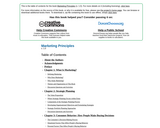
Principles of Marketing teaches the experience and process of doing marketing—not just the vocabulary. It carries five dominant themes throughout to expose students to marketing in today’s environment:
1. Service-dominant logic—This textbook employs the term “offering” instead of the more traditional first P—product. That is because consumers don’t sacrifice value when alternating between a product
and a service. They are evaluating the entire experience, whether they interact with a product, a service, or a combination. So, the fundamental focus is providing value throughout the value chain,
whether that value chain encompasses a product, a service, or both.
2. Sustainability—Increasingly, companies are interested in their impact on their local community as well as on the overall environment. This is often referred to as the “triple bottom line” of financial, social, and environmental performance.
3. Ethics and social responsibility—Following on the sustainability notion is the broader importance of ethics and social responsibility in creating successful organizations. The authors make consistent
references to ethical situations throughout chapter coverage and end-of-chapter material in most chapters will encompass ethical situations.
4. Global coverage—Whether it is today’s price of gasoline, the current U.S. presidential race, or Midwestern U.S. farming, almost every industry, and companies need strong global awareness. And today’s marketing professionals must understand the world in which they and their companies operate.
5. Metrics—Firms today have the potential to gather more information than ever before about their current and potential customers. That information gathering can be costly, but it can also be very revealing. With the potential to capture so much more detail about microtransactions, firms should now be more able to answer, “Was this marketing strategy really worth it?” and “What is the marketing ROI?” and finally, “What is this customer or set of customers worth to us over their lifetime?”
In this second edition, you’ll also find more emphasis on omnichannel marketing, social media in marketing, and the other components of the digital media revolution that are changing marketing so rapidly. Examples, videos, illustrations, and more reflect the latest in how marketing gets done.
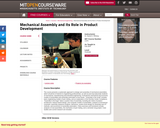
Introduces mechanical and economic models of assemblies and assembly automation on two levels. "Assembly in the small" comprises basic engineering models of rigid and compliant part mating and explains the operation of the Remote Center Compliance. "Assembly in the large" takes a system view of assembly, including the notion of product architecture, feature-based design and computer models of assemblies, analysis of mechanical constraint, assembly sequence analysis, tolerances, system-level design for assembly and JIT methods, and economics of assembly automation. Case studies and current research included. Class exercises and homework include analyses of real assemblies, the mechanics of part mating, and a semester long project.

This site contains a broad overview of the mechanical engineering program at the Massachusetts Institute of Technology. It is one of the broadest and most versatile of the engineering professions. The site features lecture notes, assignments, solutions, online textbooks, projects, study groups and exams. This is a nice broad overview of available courses within this program.
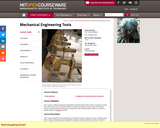
Introduces the fundamentals of machine tool and computer tool use. Students work with a variety of machine tools including the bandsaw, milling machine, and lathe. Instruction given on the use of the Athena network and Athena-based software packages including MATLABĺ¨, MAPLEĺ¨, XESSĺ¨, and CAD. Emphasis on problem solving, not programming or algorithmic development. Assignments are project-oriented relating to mechanical engineering topics. It is recommended that students take this subject in the first IAP after declaring the major in Mechanical Engineering. From the course home page: This course was co-created by Prof. Douglas Hart and Dr. Kevin Otto.
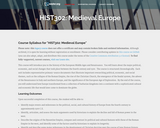
This course will introduce the student to the history of the European Middle Ages and Renaissance. The student will learn about the major political, economic, and social changes that took place between the fourth century and 1500 CE. By the end of the course, the student will understand how Europe transformed from a collection of barbarian kingdoms into a continent with a sophisticated cultural and economic life that would later come to dominate the globe. Upon successful completion of this course, the student will be able to: think analytically about the history of the European Middle Ages from the fourth century to approximately 1500; identify and describe the causes for the dissolution of the Roman Empire and the end of antiquity; identify and describe the rise and fall of the Byzantine Empire as well as the creation of Germanic kingdoms in the former western Roman Empire; identify and describe the impact of Christianity on Byzantium and the Germanic tribes; identify and describe the causes of the rise of the Carolingian Empire and its impact on Europe; identify and analyze the causes for the rising power of feudal medieval kingdoms; identify and describe the role of the medieval Church as well as the causes and effects of the Crusades; analyze and describe the system of feudalism in medieval Europe; identify the medieval roots of the Renaissance and analyze its impact on European society; identify the major cultural, scientific, and economic achievements of medieval civilization; analyze and interpret primary source documents from the fourth century to 1500, and demonstrate an understanding of the difference between primary and secondary sources. (History 302)
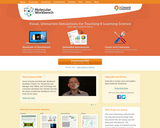
Created by the Concord Consortium, the Molecular Workbench is "a modeling tool for designing and conducting computational experiments across science." First-time visitors can check out one of the Featured Simulations to get started. The homepage contains a number of curriculum modules which deal with chemical bonding, semiconductors, and diffusion. Visitors can learn how to create their own simulations via the online manual, which is available here as well. The Articles area is quite helpful, as it contains full-text pieces on nanoscience education, quantum chemistry, and a primer on how transistors work. A good way to look over all of the offerings here is to click on the Showcase area. Here visitors can view the Featured simulations, or look through one of five topical sections, which include Biotech and Nanotechnology. Visitors will need to install the free Molecular Workbench software, which is available for Windows, Linux, and Mac.
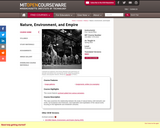
This class examines the relationship between the study of natural history, both domestic and exotic, by Europeans and Americans, and exploration and exploitation of the natural world, focusing on the eighteenth and nineteenth centuries.
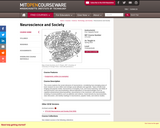
This course explores the social relevance of neuroscience, considering how emerging areas of brain research at once reflect and reshape social attitudes and agendas. Topics include brain imaging and popular media; neuroscience of empathy, trust, and moral reasoning; new fields of neuroeconomics and neuromarketing; ethical implications of neurotechnologies such as cognitive enhancement pharmaceuticals; neuroscience in the courtroom; and neuroscientific recasting of social problems such as addiction and violence. Guest lectures by neuroscientists, class discussion, and weekly readings in neuroscience, popular media, and science studies.
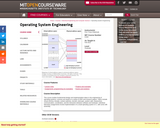
This course teaches the fundamentals of engineering operating systems. The following topics are studied in detail: virtual memory, kernel and user mode, system calls, threads, context switches, interrupts, interprocess communication, coordination of concurrent activities, and the interface between software and hardware. Most importantly, the interactions between these concepts are examined. The course is divided into two blocks; the first block introduces one operating system, UNIXĺ¨ v6, in detail. The second block of lectures covers important operating systems concepts invented after UNIXĺ¨ v6, which was introduced in 1976.
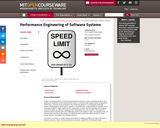
Modern computing platforms provide unprecedented amounts of raw computational power. But significant complexity comes along with this power, to the point that making useful computations exploit even a fraction of the potential of the computing platform is a substantial challenge. Indeed, obtaining good performance requires a comprehensive understanding of all layers of the underlying platform, deep insight into the computation at hand, and the ingenuity and creativity required to obtain an effective mapping of the computation onto the machine. The reward for mastering these sophisticated and challenging topics is the ability to make computations that can process large amount of data orders of magnitude more quickly and efficiently and to obtain results that are unavailable with standard practice. This class is a hands-on, project-based introduction to building scalable and high-performance software systems. Topics include performance analysis, algorithmic techniques for high performance, instruction-level optimizations, cache and memory hierarchy optimization, parallel programming, and building scalable distributed systems. The course also includes design reviews with industry mentors, as described in this MIT News article.